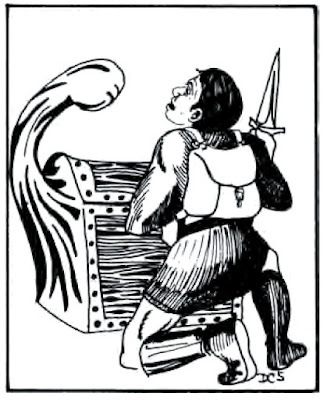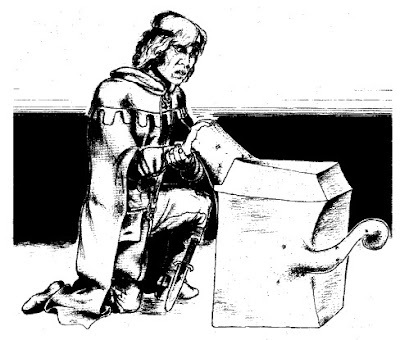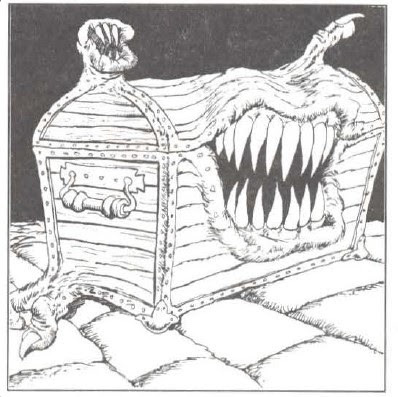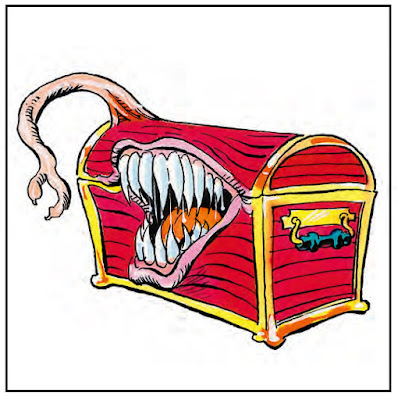Mimic Mysteries
Among the many monsters whose origins can definitively be linked to Dungeons & Dragons is the shapeshifting mimic, which first appeared in the AD&D Monster Manual (1977). Here's Dave Sutherland's illustration of the creature:
 I'm both a fan of mimics in general and of this illustration in particular, because it accurately depicts the mimic punching the nearby adventure. The text of the Monster Manual states plainly that the mimic "lashes out with a pseudopod, delivering 3–12 points of damage per hit." There's no mention, let alone implication, that the mimic can bite its prey.
I'm both a fan of mimics in general and of this illustration in particular, because it accurately depicts the mimic punching the nearby adventure. The text of the Monster Manual states plainly that the mimic "lashes out with a pseudopod, delivering 3–12 points of damage per hit." There's no mention, let alone implication, that the mimic can bite its prey. The illustration accompanying Ed Greenwood's "The Ecology of the Mimic" in issue #75 of Dragon (July 1983) is similarly accurate to the MM description. Indeed, it also includes another detail from the Monster Manual description that is often forgotten: the glue a mimic's skin secretes and that holds its victim fast, thereby making them an easier target to pummel with its pseudopod.
 Unless I have missed another example – and please tell me in the comments if I have – the above illustration (by Roger Raupp) is only the second time this iconic D&D monster had been portrayed in artwork. What strikes me about Raupp's illustration (no pun intended) is that it's completely in keeping with the text of the Monster Manual. If anything, it's even truer to the text than Sutherland's original, since it also highlights the creature's sticky qualities.
Unless I have missed another example – and please tell me in the comments if I have – the above illustration (by Roger Raupp) is only the second time this iconic D&D monster had been portrayed in artwork. What strikes me about Raupp's illustration (no pun intended) is that it's completely in keeping with the text of the Monster Manual. If anything, it's even truer to the text than Sutherland's original, since it also highlights the creature's sticky qualities.The next time we get a mimic illustration – again, unless I am mistaken – is volume 2 of the AD&D Second Edition Monstrous Compendium (1989).
 This illustration, by Daniel Horne, interests me for a couple of reasons. Most obviously, this is the first time – if I'm mistaken, you know the drill – a mimic is depicted as having a tooth-filled mouth, though it's notable that the mouth here is not associated with the hinged top of the chest it's mimicking, as is commonplace nowadays. Equally notable are the secondary mouth and clawed finger and foot that also extrude from the monster's body, though I'm not certain what purpose they serve. The 2e written description of the mimic makes no mention of its ability to bite an opponent. Instead, there's still a reference to "lash[ing] out with a pseudopod."
This illustration, by Daniel Horne, interests me for a couple of reasons. Most obviously, this is the first time – if I'm mistaken, you know the drill – a mimic is depicted as having a tooth-filled mouth, though it's notable that the mouth here is not associated with the hinged top of the chest it's mimicking, as is commonplace nowadays. Equally notable are the secondary mouth and clawed finger and foot that also extrude from the monster's body, though I'm not certain what purpose they serve. The 2e written description of the mimic makes no mention of its ability to bite an opponent. Instead, there's still a reference to "lash[ing] out with a pseudopod."For the sake of completeness, here's the illustration of the mimic found in 1993's Monstrous Manual (by an unknown artist, or at least one I cannot identify easily):
 This one looks very similar to and possibly inspired by the one in the 1989 Monstrous Compendium, although it possesses only a single extrusion beyond the tooth-filled mouth. The accompanying text is, so far as I can tell, identical to that of the Monstrous Compendium of a few years previous, right down to its attacking with a pseudopod.
This one looks very similar to and possibly inspired by the one in the 1989 Monstrous Compendium, although it possesses only a single extrusion beyond the tooth-filled mouth. The accompanying text is, so far as I can tell, identical to that of the Monstrous Compendium of a few years previous, right down to its attacking with a pseudopod. What fascinates me is how limited our collective imagination of mimics has become over the years. Gary Gygax's original description of them in 1977 notes that "they are able to perfectly mimic stone or wood" and "pose as stonework, door, chests, or any other substance or item they can imitate." Greenwood's ecology article picks up on this, offering an example of a mimic that had assumed the form of a statue in a market square and then preyed on unsuspecting derelicts on dark nights. By contrast, the Monstrous Compendium description, while retaining the original's ability to mimic stone or wood, states only that "they usually appear in the form of treasure chests."
I won't go so far as to lay the blame for the popular conception of mimics as monstrous chests with big teeth solely on the Monstrous Compendium, though I'm sure it played a role. Rather, I think the fault lies with the simple fact every illustration of the monster from the TSR era of Dungeons & Dragons depicts it as a chest and that's proved a difficult image to shake – so difficult that that's what mimics are for most players of the game. They simply cannot imagine them any other way. Needless to say, I think that's a shame, but what can you do?
Published on January 05, 2024 05:44
No comments have been added yet.
James Maliszewski's Blog
- James Maliszewski's profile
- 3 followers
James Maliszewski isn't a Goodreads Author
(yet),
but they
do have a blog,
so here are some recent posts imported from
their feed.



